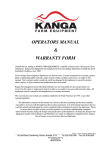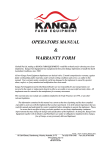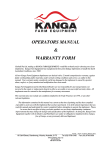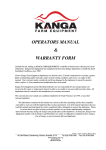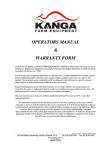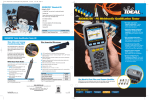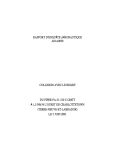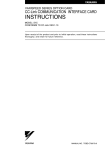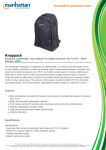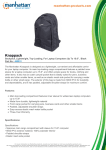Download OPERATORS MANUAL & WARRANTY FORM
Transcript
OPERATORS MANUAL & WARRANTY FORM Gavhall Pty Ltd, trading as KANGA FARM EQUIPMENT, would like to thank you for choosing one of our implements. Kanga Farm Equipment has manufactured three point linkage implements to handle the harsh Australian Conditions, since 1982. All new Kanga Farm Equipment Implements are backed with a 12 month comprehensive warranty, against faulty workmanship and/or materials, under normal working conditions and service, as outline in this manual. Your warranty maybe considered void if any damaged to the implement is caused by operator abuse, neglect, or if any unauthorized modifications have been made. Kanga Farm Equipment and its Distributors/Dealers are not responsible for any transportation cost incurred in the repair or replacement of parts in either a successful or non-successful warranty claim. All implements must be returned to the manufacture for warranty assessment. This warranty does not exclude any conditions implied by the Trade Practices Act 1974, or any other relevant legislation. The information contained in this manual was current at the time of printing and has been compiled especially to assist you with the Implement that you have purchased. It is of the utmost importance that you read this manual and understand the context completely before attempting to operate the implement. Please be aware that in an effort to bring you better products we are always implementing continuous improvements that may change the designs and specifications of the Implement. In doing this, Kanga Farm Equipment together with its Dealers and Distributors are under no obligation to implement these changes, free of charge, on any previously delivered Implement Kanga - Other Products Manual.docx 16 Cahill Street, Dandenong, Victoria, Australia, 3175 Tel: (03) 9706 5166 (PROP. GAVHALL PTY LTD) ACN 006 050 657 ABN 59 918 752 500 Fax: (03) 9706 5050 TO THE DEALER Assembly and proper installation of this product is the responsibility of the KANGA FARM EQUIPMENT dealer. The dealer must complete all items on the Warranty Registration & Installation Form included in this manual before releasing the implement to the new owner. Both dealer and customer must sign the registration, which certifies that all Dealer Checklist items have been completed. The dealer must return a copy of the Warranty Registration & Installation Form to Kanga Farm Equipment. Reminders about Warranty Registration that have not been returned will be sent out to demonstrate that reasonable attempts have been made to ensure dealers complete risk assessment and pre-delivery obligations. TO THE OWNER Read this manual before operating your KANGA FARM EQUIPMENT implement. The information presented will prepare you to do a much better and safer job. Keep this manual handy as a reference. Ensure all operators read this manual carefully and become acquainted with all the adjustments and operating procedures before attempting to operate. Keep a record that the operator has read and understands the correct operating procedures as outline in this manual. The implement you have purchased has been carefully engineered and manufactured to provide dependable and satisfactory use. Like all mechanical products, it will require routine cleaning, upkeep and maintenance. Lubricate the implement as specified. Observe all safety information in this manual and safety decals on the implement. Throughout this manual the term IMPORTANT is used to indicate that a failure to observe can cause damage to the equipment. The terms CAUTION, WARNING and DANGER are used in conjunction with the Safety-Alert Symbol (triangle with an exclamation mark) to indicate the degree of risk to your personal safety. This Safety-Alert Symbol indicates a hazard and means ATTENTION! BE CAREFUL! YOUR SAFETY IS INVOLVED! DANGER indicates an imminently hazardous situation, which if not avoided, will result in death or serious injury. WARNING indicates a potentially hazardous situation, which if not avoided, could result in death or serious injury. CAUTION indicates a potentially hazardous situation, which if not avoided, may result in minor or moderate injury. It may also be used to alert against unsafe practices. GENERAL INFORMATION The purpose of this manual is to assist you in operating and maintaining your KANGA implement. Read it carefully. It provides information and instructions that will help you achieve years of dependable performance. These instructions have been compiled from extensive field experience and engineering data. Some information may be general in nature due to the unknown and varying operating conditions. However, through experience and these instructions, you should be able to develop procedures suitable to your particular situation. The illustrations and data used in this manual were current at the time of printing, but in an effort to bring you better products we are always implementing continuous improvements that may vary your implement slightly in detail. We reserve the right to redesign and change the machine as may be necessary without notice. Some illustrations in this manual show the Digger with Safety Shields removed to provide a better view. The Slasher should never be operated with any safety shielding removed. Throughout this manual, references are made to right and left direction. These are determined by standing behind the equipment facing the direction of forward travel. Blade rotation is as if viewed from the top. 2 Carryalls Adj. Round Bale Fork Jib Crane Bale Spike Silage Fork 35 SPECIFICATIONS 1200 Carryall 3 – Point Linkage … … … … … … … … … … … … … … … … 3 – Point Linkage Type ………………………………… Frame Reinforcing …………………………………… Dimensions ………………………………………… Overall Height ………………………………………… Floor Material ………………………………………… Max Capacity ………………………………………… Category 1 Single Pin Angle 1200 x 900 800mm Hardwood Boards 250 kg 1500 Carryall 3 – Point Linkage … … … … … … … … … … … … … … … … 3 – Point Linkage Type ………………………………… Frame Reinforcing …………………………………… Dimensions ………………………………………… Overall Height ………………………………………… Floor Material ………………………………………… Max Capacity ………………………………………… Category 1 Single Pin Rolled Hollow Section (RHS) 1500 x 1060 800mm Hardwood Boards 350 kg 1800 Carryall 3 – Point Linkage … … … … … … … … … … … … … … … … 3 – Point Linkage Type ………………………………… Frame Reinforcing …………………………………… Dimensions ………………………………………… Overall Height ………………………………………… Floor Material ………………………………………… Max Capacity ………………………………………… Category 1 Single Pin Rolled Hollow Section (RHS) 1800 x 1060 800mm Hardwood Boards 400 kg Jib Crane 3 – Point Linkage … … … … … … … … … … … … … … … … Frame Material …………………………………… Frame Material Dimensions …………………………… No. of Lift Points … … … … … … … … … … … … … … … … Max. Lift Height … … … … … … … … … … … … … … … … Lift Capacity (kg) … … … … … … … … … … … … … … … … Approximate Weight … … … … … … … … … … … … … … Category 1 Double Clevis Rolled Hollow Section (RHS) 100 x 100 x 5 2 2500mm 300 - 450 65 kg Adjustable Round Bale Feed Out Fork 3 – Point Linkage … … … … … … … … … … … … … … … … Frame Material …………………………………… Frame Material Dimensions …………………………… Spike Material ………………………………………… Spike Type ………………………………………… No. of Spikes ………………………………………… Approximate Weight ………………………………… Category 1 Double Clevis Rolled Hollow Section (RHS) 90 x 90 x 5 50mm Solid Tapered Locking 2 130 kg Bale Spike 3 – Point Linkage … … … … … … … … … … … … … … … … 3 – Point Linkage Type ………………………………… Frame Material …………………………………… Large Spike … … … … … … … … … … … … … … … … … Category 1 Double Clevis Flat/RHS Replaceable Straight Conus 2 1240mm long with tapered Nut Small Spike … … … … … … … … … … … … … … … … … High tensile No. of Spikes ………………………………………… 2 Approximate Weight … … … … … … … … … … … … … 60 kg Max. Lift Capacity … … … … … … … … … … … … … … 500kg 36 Silage Fork 3 – Point Linkage … … … … … … … … … … … … … … … … 3 – Point Linkage Type ………………………………… Frame Material …………………………………… Spike …………………………………………… Category 1 Double Clevis Flat/RHS Replaceable Straight Conus 2 1240mm long with tapered Nut No. of Spikes ………………………………………… 2 Approximate Weight … … … … … … … … … … … … … 87 kg Max. Lift Capacity … … … … … … … … … … … … … … 1000kg SAFETY RULES & ACCCIDENT PREVENTION ATTENTION! BE CAREFUL! YOUR SAFETY IS INVOLVED! Replace Immediately if Damaged Kanga Carryalls Jib Crane Bale Spike Round Bale Feed Out Fork Silage Fork 1 – Serial Number Plate 2 – Kanga Logo 4 – Safety Decal 5 – Safety Decal 6 – Safety Decal 7 – Safety Decal 37 SAFETY RULES & ACCCIDENT PREVENTION ATTENTION! BE CAREFUL! YOUR SAFETY IS INVOLVED! Safety is a primary concern in the design and manufacture of our products. Unfortunately, our efforts to provide safe equipment can be wiped out by a single careless act of an operator. In addition to the design and configuration of equipment, hazard control and accident prevention are dependent upon the awareness, concern, prudence and proper training of personnel involved in the operation, transport, maintenance and storage of equipment. It has been said, “The best safety device is an informed careful operator.” We ask you to be that kind of operator. • • • • • • • • • • • • • • • • • Safety instructions are important! Read all attachments and unit manuals; follow all safety rules and safety decal information. Failure to follow instructions can result in serious injury or death. If you do not understand any part of this manual and need assistance the Department of Agriculture, Occupational Health & Safety Offices, any Agricultural School or college and your local dealer should be able to direct you on where you can received appropriate training. No operator however experienced in farm machinery operation they maybe, should attempt to use any piece of machinery that they have not been competently trained to use. Keep hands and body away from pressurized lines. Use paper or cardboard, not hands or other body parts to check for leaks. Wear safety goggles. Hydraulic fluid (oil) under pressure can easily penetrate the skin and will cause serious injury or death. Make sure that all operating and service personnel know that if hydraulic fluid (oil) penetrates the skin, it must be surgically removed as soon as possible by a doctor familiar with this form of injury or gangrene, serious injury or death will result. CONTACT A PHYSICAN IMMEDIATELY IF FLUID ENTERS SKIN OR EYES. DO NOT DELAY. Know your controls and how to stop quickly in an emergency. Operators must be instructed in and be capable of the safe operation of the equipment and all controls. Do not allow anyone to operate this equipment without proper instruction. Do not allow children or untrained persons to operate equipment. Check that all hardware is tight and properly installed. Always wear relatively tight fitted clothing to avoid entanglement in moving parts. Wear heavy-duty, rough-soled boots and protective equipment for eyes, hair, hands, hearing and head. Ensure implement is properly attached, adjusted and in a good condition so that it can be operate safely. Tractors MUST be fitted with Roll Over Protection Structure (ROBS) or ROBS Cap. It is also advisable that your tractor be fitted with a seatbelt, where fitted it must be worn at all times. Falling from your tractor can result in death from being run over or crushed. If your tractor is fitted with a folding ROBS, keep it in the “locked up” position at all times. Inspect chains, shackles, deflectors and any wear parts for damage. Replace if damaged. Remove any debris that has accumulated on the implement, tractor or engine to avoid fire hazard. Ensure all safety decals are installed. Replace if damaged. A minimum 20% of tractor and equipment weight must be on the tractor’s front wheels with implement in the transport position. Without this weight, tractor could tip over causing personal injury or death. The weight maybe attained with a loader, front wheel weights, and ballast in the tires or front tractor weights. When attaining the minimum 20% weight on the front wheels, you must not exceed the ROPS max ballasted mass certificate. Weight the tractor and implement. Do not estimate. Watch for hidden hazards on the terrain during operation and avoid any hazards or object that could cause injury or damage. Inspect operating area, remove where possible any stones, branches or foreign objects that may cause injury or damage. It is very important to always watch for foreign objects in the area you are operating and avoid any that could cause injury or damage. 38 • • • • • • • • • • • • • • • • • • • • • • • • • When working in populated areas always place signs in the area to alert people or vehicles that may pass. Operation must be stopped when anyone comes within 50 meters. Keep all people and animals away from the implement during start up, operating and when stopping. Do not operate the implement or tractor while under the influence of drugs or alcohol. Operate only in daylight or good artificial light. Keep hands, feet, hair, and clothing away from moving parts while engine is running. Do not carry persons or objects on the Implement or tractor during work or while in transit. For transportation on public roads the operator must ensure that the tractor and implement complies with current State and Federal laws and must strictly adhere to all road traffic regulations in force in his/her particular state. Always operate equipment from the seat of the tractor with the seat belt securely fastened especially when operating controls or starting engine. Place transmission in neutral, engage break and ensure all other controls are disengaged before starting tractor engine. Look down and to the rear and make sure area is clear and safe before operating in reverse. Do not operate on steep slopes. If in doubt set rear axles wider for moderate slopes. Do not stop, start or change directions suddenly on slopes’, working up and down is preferred. Use extreme care and reduce ground speed on slopes and rough terrain. Stop implement, then tractor, immediately upon striking an obstruction. Turn off engine, remove key, inspect and repair any damage before resuming operations. Always block implement when inspecting. Before commencing any adjustment, maintenance, or cleaning. Always switch off the tractor engine, remove key and wait until all moving parts have come to a complete stop, then ensure the machine is on the ground or on a robust secure support. Before dismounting tractor or performing any service or maintenance lower the 3-point linkage and any other raised components (i.e. loader bucket) to the ground. Operate valve levers to release any hydraulic pressure, stop engine, set parking brake, remove key and unfasten seat belt. Never place any part of the body underneath the implement or between moveable parts even when engine has been turned off. Hydraulic systems can “creep” (i.e. slowly lower). They may fail or movement of the control levers can cause the implement to drop or rotate unexpectedly causing severe injury or death. Follow Operator’s Manual instructions for working on your implement or have servicing carried out by a qualified dealer. During routine checks and/or repairs ensure that no one can switch on the tractor or Implement accidentally. Keep the key to the tractor in your pocket. For your own safety and that of others and to avoid forfeiting your warranty, use only original spare parts. Do not modify/alter or permit anyone else to modify/alter the implement or any of its components. Ensure implement is properly attached, adjusted and in good operating condition. Always use genuine Kanga replacement parts. Firmly tighten all nuts, bolts, screws and shackles before operating. If worn or damaged then replace immediately. Block implements securely for storage. Keep children and bystanders away from storage area. Kanga Farm Equipment accepts no responsibility or liability for any losses, injuries or damages that may result from failing to observe these safety rules and the safety decals on the implement. 39 OPERATION Safety is a primary concern in the design and manufacture of our products. Unfortunately, our efforts to provide safe equipment can be wiped out by a single careless act of an operator. In addition to the design and configuration of equipment, hazard control and accident prevention are dependent upon the awareness, concern, prudence and proper training of personnel involved in the operation, transport, maintenance and storage of equipment. It has been said, “The best safety device is an informed careful operator.” We ask you to be that kind of operator. The operator is responsible for the safe operation of this implement. The Operator must be properly trained. Operators should be familiar with the implement and tractor and all safety practices before starting operation. Read the safety rules and safety decal information on pages 38, 39 & 40. • • • • • • • Do not allow children or untrained persons to operate this implement Keep all people and animals away from the implement during start up, operating and when stopping. Keep all persons away from the operator control area when performing adjustments, service or maintenance. Never place any part of the body underneath the implement or between moveable parts even when engine has been turned off. Hydraulic systems can “creep” (i.e. slowly lower). They can fail or movement of the control levers can cause the implement to drop or rotate unexpectedly causing severe injury or death. Follow Operator’s Manual instructions for working on your implement or have servicing carried out by a qualified dealer. Keep all persons away from operators control area while performing adjustments, service or maintenance. Service work does not require going underneath this implement. Read Operators Manual for service instructions or have work carried out by a qualified dealer. No passengers on this equipment. • When operating along roads, pathways or highly populated areas always place signs in the area to alert people or vehicles that may be passing. Operation must be stopped when anyone comes within 50 meters. • Stop implement, then tractor, immediately upon striking an obstruction. Turn off engine, remove key, inspect and repair any damage before resuming operations. Always wear relatively tight fitted clothing to avoid entanglement in moving parts. Wear heavy-duty, rough-soled boots and protective equipment for eyes, hair, hands, hearing and head. A minimum 20% of tractor and equipment weight must be on the tractor’s front wheels with implement in transport position. Without this weight, tractor could tip over causing personal injury or death. The weight maybe attained with a loader, front wheel weights, and ballast in the tires or front tractor weights. When attaining the minimum 20% weight on the front wheels, you must not exceed the ROPS max ballasted mass certificate. Weight the tractor and implement. Do not estimate. • • ATTACHING TO THE IMPLEMENT • • • When connecting the tractor to the implement never stand in between the tractor and the implement and always find somewhere level or flat. The implement you have purchased should not be mounted on tractors greater than that specified in the “Specifications: section of this manual. Always adjust the tractor lower linkage arms anti-sway devices to prevent implement from swing from side to side during transport and operation. Failure to do so may result in serious injury or damage. Damage like bent and twisted implement towers are NOT covered by warranty. 40 41 ASSEMBLY INSTRUCTIONS • • • • • Before dismounting tractor or performing any service or maintenance disengages power to implement, lower the 3-point linkage and any other raised components (i.e. loader bucket) to the ground. Operate valve levers to release any hydraulic pressure, stop engine, set parking brake, remove key and unfasten seat belt (if fitted). Never place any part of the body underneath the implement or between moveable parts even when engine has been turned off. Hydraulic systems can “creep” i.e. slowly lower. They can fail or movement of the control levers can cause the implement to drop or rotate unexpectedly causing severe injury or death. Follow Operator’s Manual instructions for working on your implement or have work carried out by a qualified dealer. During routine checks and/or repairs ensure that no one can switch on the tractor or Implement accidentally. Keep the key to the tractor in your pocket. Service work does not require going underneath this implement. Read Operators Manual for service instructions Always wear relatively tight fitted clothing to avoid entanglement in moving parts. Wear heavy-duty, rough-soled boots and protective equipment for eyes, hair, hands, hearing and head. Assembly of this implement is the responsibility of the KANGA FARM EQUIPMENT dealer. It should be delivered to the new owner completely assembled and adjusted for normal conditions. The Kanga Carryalls do not require assembly. Kanga Tipping Carryalls, Scoops and Shovels do not require any assembly unless the bucket is to be fitted. If the bucket needs to be fitted follow these instructions. 1) Place frame on a robust support and make sure the implement cannot fall. 2) Line up the frame with the bucket and slide frame over bucket. 3) Lift one side of the frame and secure with Nyloc Nut and Bolt. DO NOT TIGHTEN. 4) Lift other side into place and secure with Nyloc Nut and Bolt. 5) Tighten both sides but only until the bolts just become tight. Over tightening will result in the bucket not tipping. Under tightening will mean the bucket can sway from side to side. Kanga Bale Spikes/Silage Forks do not require any assembly unless the Conus 2 tines have not been fitted. To fit tines, slide the tine into the bushing that is already welded in place and tighten the tapered nut to a torque of 460ft lbs. Jib Crane A tractor is required during assembly of a Jib Crane. A tractor will make part of the fit up, alignment and handling easier. First connect the A Frame to the tractors Lower Linkage Arms with the Lower Linkage Pins supplied and secure with lynch pins. Then attach Boom to the top link point of the tractors 3-point linkage (top link pin not supplied). Align A Frame with the holes on the boom, start with middle hole, and secure into position with Bolt/Pin. Adj. Round Bale Fork If unassembled the tines will need to be fixed to the tool bar/headstock and secured with bolts supplied. The tines can be setup on either the left or the right. This gives the operator greater flexibility and means he can use the bale on different sized bales. DAILY PRE-OPERATION CHECKLIST (Operators Responsibility) □ □ □ □ □ □ Review and follow safety rules outlined in this manual Check that implement is properly and securely attached to the tractor Check all hardware (i.e. bolts, nuts, wood flooring, etc) are properly installed, secured and in good condition. Check trip mechanism is well greased and working correctly Ensure tractor transmission is in neutral before starting engine. Inspect area that you will be operating in and remove any object that may cause injury or damage. Complete dealer checklist when assembly is complete. 43 Agricultural Machinery Product OHS Compliance Form We, Of, Gavhall Pty Ltd t/as Kanga Farm Equipment 16 Cahill Street Dandenong, Victoria, Australia, 3175 Telephone: 03-9706-5166 Fax: 03-9706-5050 Confirm that the following machine(s) Kanga Carryalls Kanga Jib Crane Kanga Adjustable Round Bale Fee Out Fork Kanga Bale Spike Kanga Silage Fork have had a hazard identification, risk assessment and risk control procedure carried out on a representative model of the aforementioned product(s) in accordance with the Occupational Health and Safety requirements of all states and territories of Australia and where found necessary the appropriate risk control measures have been incorporated in the product specifications. The Operators Manual contains the necessary Health and Safety information and safety warnings decals are applied to the product where necessary. Product Description: Model Number(s): Name: Position Carryalls / Rear End Loaders / Bale Handling Equipment Carryall - Product Code(s) 98000, 98500, 99500 Jib Crane – Product Code(s) 96000 Adj. Round Bale Feed Out Fork – Product Code(s) 93000 Silage Fork – Product Code(s) 94000 Bale Spike – Product Code(s) 95000 Bruce J Alcott Managing Director Date: 01 / 10 / 2003 Details of the unit assessed for the purpose of compliance Model # Size S Range Carryall 1.5m x 0.9m (5x3) Jib Crane Adj. Bale Feed Out Fork Bale Spike Silage Fork Serial # Date of Inspection 1130903 151002 010902 150409 170409 23 / 09 / 2003 23 / 09 / 2003 23 / 09 / 2003 20 / 04 / 2009 20 / 04 / 2009 44 Location 16 Cahill Street 16 Cahill Street 16 Cahill Street 16 Cahill Street 16 Cahill Street WARRANTY REGISTRATION & INSTALLATION FORM Owners Name: _______________________________________________ Town: _ _ _ _ _ _ _ _ _ _ _ _ _ _ _ _ _ _ _ _ _ _ _ _ _ _ _ State: _ _ _ _ _ _ _ _ _ _ _ _ P/Code: _ _ _ _ Type of Implement Purchased □ Post Hole Digger □ Mini Range □ M Range □ H Range □ XH Range (50hp) □ XH Range (75hp) □ Box Scrapper □ 1200mm □ 1800mm □ 2400mm □ Carryall □ 4’ x 3’ □ 5’ x 3’6” □ 6’ x 3’6” □ Cultivator □ Eurotiller (5 / 7 / 9 / 11 Tine) □ S Tine (2.4m / 2.8m / 3.0m / 3.2m) □ Chisel Plough (5 / 7 / 9 / 11 Tine) □ Pallet Fork □ 500kg □ 1000kg □ Bale Equip. □ Spike □ Silage Fork □ Adj. Bale Feed Out Fork □ Ripper □ H Range 3 Tine □ M Range 3 Tine □ H Range Single Tine □ M Range Single Tine □ Mini Single Tine □ Stick Rake □ 1800mm □ 2400mm □ 3000mm □ Harrows □ 2400mm □ 3000mm □ 3600mm □ 4000mm (Harrow Rake) □ Other (Please Specify) ____________________________________________________________________________________ Serial Number ___________________ Month of Manufactured: □ Jan □ Feb □ Mar □ Apr □ May □ Jun □ Jul □ Aug □ Sept □ Oct □ Nov □ Dec Year of Manufacture _ _ _ _ Date of Purchased _ _ / _ _ / _ _ _ _ Intended areas of use: □ Paddocks Only □ Close to Sheds & Buildings □ Near Roads □ Contracting, please specify: _ _ _ _ _ _ _ _ _ _ _ _ _ _ _ _ _ _ _ _ _ _ _ _ _ _ _ _ _ _ _ _ _ _ _ _ _ _ □ Other, please specify: _ _ _ _ _ _ _ _ _ _ _ _ _ _ _ _ _ _ _ _ _ _ _ _ _ _ _ _ _ _ _ _ _ _ _ _ _ _ _ _ _ _ _ _ _ _ _ _ _ _ _ I have been fully instructed in the operation of this unit in the actual working conditions that I intended to operate and I am satisfied that I can use it safely. I acknowledge that I have been fully instructed in the care, maintenance, lubrication and that Kanga Implements have been designed for agricultural use in area away from people, animals, roads and property. I understand that there are Federal and State Laws as well as OH&S Standards that dictate how I can operate should I wish to operate along roads or in any populated areas and that it is my responsibility to know and adhere to those laws. I have received a copy of the operating manual and the dealer has instructed me to read the manual in full before commencing any operations. _________________ O w n e r’ s S i g n a t u r e. __/__/____ Date □ FINAL ASSEMBLY – Checked all hardware to ensure it is firmly tightened as outlined in the Operators Manual. Customer has been instructed on how to make regular checks and tighten ALL hardware (i.e. all nuts and bolts). □ LUBRICATION – The implement has been lubricated and oil levels have been checked in all chain/gearbox transmissions. Customer has been instructed on how to check oil levels and lubricate implement. □ GREASING & MAINTENANCE – Grease bearings, universals and ensure PTO shaft has been. Instruct customer how to re-grease the implement. Explain to the operator the requirements and repercussions of regular maintenance. □ CLUTCH ADJUSTMENT – Check that clutch has been correctly fitted and nuts are tight. Check the clutch has been adjusted for the customer’s situation. Instruct customer that an annual service is required. □ IMPLEMENT, DRIVESHAFT & TRACTOR COMPATIBILITY – Check implement and PTO compatibility, ensuring the PTO will not foul on the tractor or implement during linkage operation. If PTO was cut make sure that it was re-greased and all spring activated locking pins on the PTO Shaft move freely. □ IMPLEMEMNT & TRACTOR COMPATIBILITY – Check implement and Tractor compatibility. Ensure that a minimum 20% of tractor and equipment weight is on the tractor’s front wheels with implement in transport position. □ OPERATION PROCEDURES – I Instruct the operator on correct procedures and techniques for the type of work they have indicated they intend to carry out. General safe operating procedures can be found in the Operators Manual. Advise customer to carry out a risk assessment and hazard identification of the property and alert the customer to the type of potential dangers they should be looking to avoid. □ DANGERS – Instruct customer on the potential dangers of operating the implement. Outline the dangers associated with rotating blades, the possibility of fast moving debris, rotating PTO Shaft and ensure the customer knows that information about safe operating procedures and maintenance are in this Manual. □ OWNERS/OPERATORS MANUAL – Check that the implement has a booklet supplied. Emphasize the importance of reading the Manual. Note manuals can be down loaded from www.farmimplements.com.au Please tick the boxes above as each point has been carried out. Dealership Name: _ _ _ _ _ _ _ _ _ _ _ _ _ _ _ _ _ _ _ _ _ Pre-delivered By: _ _ _ _ _ _ _ _ _ _ _ _ _ _ _ _ _ _ _ _ Salesperson’s Name: _ _ _ _ _ _ _ _ _ _ _ _ _ _ _ _ _ _ _ _ Salesperson’s Signature: _ _ _ _ _ _ _ _ _ _ _ _ _ _ _ _ _ Top copy (manufacture’) Middle Copy (dealer’) 91 Last page (purchaser’)














